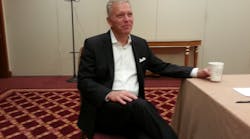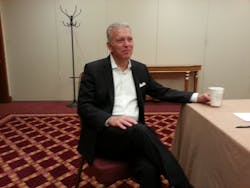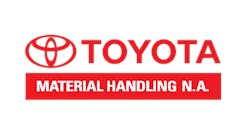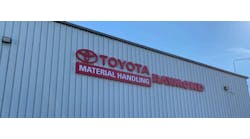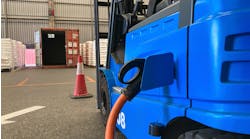Why Toyota’s Jeff Rufener is Still Bullish about Lift Trucks
This week Toyota Material Handling, U.S.A., Inc. (TMHU) officially announced the availability of its 8-Series 8,000 to 17,500 lb. lift truck line. These cushion and pneumatic tire vehicles are powered by two new Toyota-designed and built 4-cylinder diesel, LPG, gasoline and dual fuel engines.
The trucks are designed for indoor and outdoor applications such as in the paper, lumber and concrete industries, as well as in large distribution centers needing to move heavy loads. The introduction includes a 12,000 lb. paper roll special model to meet the challenges faced by the paper industry in moving paper rolls.
After a press conference, Material Handling & Logistics had the opportunity to ask Jeff Rufener, president of Toyota Material Handling USA, about what the announcement of these new products says about the health of the industrial truck industry and of the industries it serves.
MH&L: Jeff, what would you say are the biggest challenges the industrial truck industry faces these days?Rufener: The lift truck market in the US is certainly mature but from a technology standpoint there are plenty of advancements. But maturity tends to compress margins and that demands ever increasing efficiency. Coupled with that, business continues to consolidate. The drumbeat is to drive costs down. We have to find new and innovative ways to serve that market.
MH&L: Your latest product introductions include more fuel efficient engines. Any chance Toyota will bring manufacture of those engines here to the U.S., along with the trucks you make in Indiana?
Rufener: Never say never, and Toyota does manufacture some engines in the states for cars, but not for industrial equipment. For the foreseeable future I don’t see that.
MH&L: Are there other synergies to be explored between the lift truck and automotive sides of your business?
Rufener: We have a close relationship with Toyota Financial Services. The leasing business has overtaken the material handling business as the preferred way to acquire equipment. That really changed our industry. Coming from the car business and the car business’s influence, that skill spilled over into the industrial truck business. The Commercial Division is part of the car company and they have 120 people dedicated to the commercial division and most of that is dedicated to material handling.
The Talent Challenge
MH&L: Let’s talk about Toyota’s dedication to education. You donated some equipment and services to Vincennes University, and these days, for a material handling equipment OEM, that seems like an act of self preservation as well as philanthropy, considering the talent challenge in your industry. That contribution seems like a good way to keep that stream of talent flowing.
Rufener: Philanthropy is rarely one dimensional. There’s an element of doing it because it’s the right thing to do, but there’s also an element of doing it because it’s good for business. Most of the programs I’ve heard of at the college level were 4-year logistics programs and I thought it terrific they were offering technical certificates and two year associates degrees. They told us part of what they’re teaching people to do is show up every day. Young people don’t always have that fundamental notion. This is a new entry point for us. I told Vincennes’ executives to keep coming to us and keep the dialog going. As long as we keep seeing what each other are doing we’ll find additional ways to collaborate.
MH&L: The national chairman of the U.K. warehousing association said their sector has to hire 900,000 people before 2020 and that a fifth of the vacancies are hard to fill because of the skills deficit. Is the U.S. in the same boat?
Rufener: I think so. We have to rethink that whole thing. We’ve been talking for years about technician availability. It’s a very specialized skill. Today we’re talking about it even more because there’s a general set of skills important to our industry.
MH&L: What’s happening at the dealer level where skills are concerned? Dealerships have always been family run and passing the business from generation to generation. Is that still happening?
Rufener: It is, but distribution in our industry has changed a lot in the last 20 years. With our dealers distribution has consolidated and that means there are fewer capable and willing to get into material handling and distribution. Second, our dealers have grown significantly as we’ve grown. Because of the scale that means they’re ready to execute some succession plan. Unless they have a family member who is ready and willing, then they have to look to alternatives willing to buy in—and they’re fewer and farther between. That will continue to be a challenge in our industry.
MH&L: And China is certainly trying to grab a foothold in this market.
Rufener: While the numbers are still modest, any business person needs to look back at the history of our industry where competitors from places like China are taken seriously. Their quality will continue to improve—you’ll see them at trade shows. They’re starting to move into Class 2, and typically they’ve been a Class 5 provider. That expansion is likely to continue, but distribution in this country is still their Achilles Heel. The Chinese business model has been to buy U.S. brand names and distribution. That’s the threat, that this manufacturing powerhouse has the capacity to acquire a brand name and its distribution network.
MH&L: Throwing in the mergers and acquisitions that have taken place recently, is there room for more such changes in your industry?
Rufener: I don’t see a lot more opportunity for change. KION’s activity is pretty well known, but I don’t see many more NISSAN/TCM scale moves in that top group. There’ll continue to be consolidation beyond the top ten, but if something happens in the Top 10 itself I’d be surprised.
MH&L: Getting back to the talent issue, safety is a big concern in the industry as well. If training people for skill is a challenge, then training for safety must also be a challenge, even with good people. Any concerns about the state of safety?
Rufener: Almost everything Toyota does starts with a concern for safety. We always need that concern. Like all resources, natural and human, we have a limited supply. It has to be invested in and cultivated. At the top level of the TMHU organization I participate in our safety and quality meetings and the metrics that are the top line drivers when we talk about how we’re doing. Not only do we address the safety of our associates, but of our customers as well.
New Opportunities
MH&L: How do you see the growth of e-commerce affecting your industry?
Rufener: We’ve already seen Amazon’s acquisition of Kiva and their turning into a distributor. That’s been done in different ways throughout history. I would expect that to continue. Amazon understands that distribution cost is a key component of our business and they have to have an idea of how to mitigate that cost and manage it better by making it a core competency. That’s why they moved more profoundly into that space so they wouldn’t depend on a third party. There aren’t a lot of companies that will do that but it sets an example.
MH&L: What are some of Toyota’s core industry lessons as new businesses evolve with the economy?
Rufener: From a pure product standpoint, the electric category continues to grow. One of the reasons we want to continue doing business in food and beverage is because that business is self sustaining. In hard times consumers may not drink Coke but they will be drinking Sam’s Club. Consumption won’t stop. The capital goods side of the business is very volatile. You look at the 35-50% differences between peaks and valleys over the years and that’s particularly what our internal combustion [IC] customers face. And we see more opportunities for high capacity electrics with 80 volt technology.
MH&L: Anything about those opportunities you can share with us?
Rufener: We’re working on a new product introduction but that’s too far off for me to talk about. We’re already in that space but it will be a substantially improved product. As strong as we are in the Class 5 sector, for example, there’s an opportunity for us to convert users from IC Class 5 product to pneumatic tire electric. That’s a relatively small market today, but that could change fairly quickly.
MH&L: What’s the most important industry driver in the next few years?
Rufener: The change in the energy situation in this country is the most fundamental things that will occur economically. It makes me so optimistic about the future of the U.S. economy and by extension the lift truck industry. We went from five years ago when all those terrible things were happening to saying that by 2020 we could be energy independent. Not only will that reduce the cost of fossil fuels for us as consumers, but it will also substantially reduce the cost of manufacturing in the U.S., and we will be a more competitive global manufacturer as a result. MH&L
